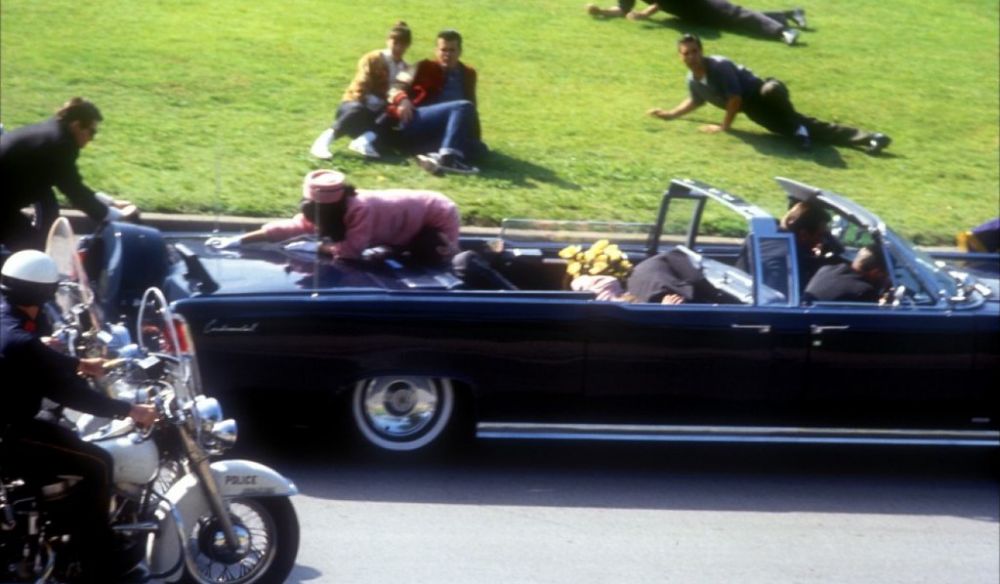
On a cold February morning five years ago, I embarked on a dark and dismal pilgrimage to Dallas, Texas, to find the exact place where John Kennedy was killed on November 22, 1963.
Before entering the old Texas School Book Depository building, I stood for a long moment near the “X” that denotes the very spot where Lee Harvey Oswald’s murderous bullets rained down on the young president as his black limousine passed the grassy knoll to the north of Elm Street. The horror that day took place in Dealey Plaza, a 15-acre city park in the West End Historic District of downtown Dallas, sometimes called the “birthplace of Dallas.”

The sixth floor of the 85-year-old brick building was christened the Sixth Floor Museum on Presidents’ Day, February 20, 1989. Up here is the sniper’s nest, where Oswald did the devil’s work. I stood in a window where the shots were fired.

(Image: Ellis Conklin)
Visitors move about slowly, quiet as ghosts. The 8 mm Zapruder film, 40 seconds of hell on earth, plays in a soundless loop, endlessly.
All of us know where we were and what we were doing upon learning that John Kennedy’s life was severed in that glaring Friday noontime in Dallas. That moment is forever fixed, the mind stopping like a clock, a bright trajectory ending in midpassage. Our pain makes us precise.
Countless times we’ve shared with others our own private story of those haunting, heart-stopping seconds. Such unthinkable vividness: The screaming, tire-squealing rush to Parkland Memorial Hospital, our parents’ helpless tears, the blood-splattered dress Jackie would not remove, (“I want them to see what they’ve done!”), and on to Arlington National Cemetery, where a little boy saluted a long mahogany box draped with the American flag.
As the great essayist Lance Morrow once wrote: “It is Kennedy’s deathday, not his birthday, that we observe.”
I recall a cold January morning in 1986 when the Challenger blew up with a school teacher aboard. TV commentators asked, “Is this their JFK moment?” The same question was asked again, when 9/11 shook our senses, with its rubble and flames and smoke and death, and later, at Columbine and Sandy Hook. “Is this their JFK moment?”
No, there has been only one JFK moment, for John Kennedy still occupies a rare and unusual place in our national psyche. Some have suggested the Sixties began that tragic day.
It is the myth of Kennedy that nearly 60 years later continues to overshadow, to outlive the substance of what he achieved.
Wrote Morrow: “The death of John F. Kennedy became a participatory American tragedy, a drama both global and intensely intimate. And yet Americans felt Kennedy’s death in a deeply personal way: they, and he, were swept into a third dimension, the mythic.”
Perhaps it is the myth, a sense of hope, that anything is possible, even going to the moon. That may be the central accomplishment of his presidency – that for one brief and shining moment we stole fire from heaven. Perhaps. As Yeats wrote, “How can we know the dancer from the dance?”
Does it matter?
When Kennedy was killed, a Washington D.C. reporter said to Daniel Patrick Moynihan, “We’ll never laugh again.”
And Moynihan, who later became a U.S. senator, is said to have famously replied, “Mary, we’ll laugh again, but we’ll never be young again.”

Well said, Ellis. You deserve a 1964 Kennedy half dollar coin for this. It’s now worth much more than four bits. You’ve got me remembering coming in from recess in November 1963, and interviewing a school district superintendent in January 1986, and also remembering my visit to Dallas in March 2011 and seeing the grassy knoll and the sixth floor. Very eerie. One minor quibble. When I first saw the “iconic” headline, thought it might be about Dubya. After all, I also remember the first and possibly only “DUBYA” headline I ever saw. So thanks for the memories!
Ellis, Unfortunately you have reiterated the tired and false story of JFK’s assassination. Either you are not acquainted with the thorough scholarship and revision that has ably shown the mainstream orthodox interpretation of JFK’s death to be shallow, misleading and plain wrong; or you have studiously avoided looking into some of the more cogent arguments for a far more sinister and wider-ranging political analysis that demonstrates the absurdity of a lone gunman, a known inept rifleman who just happened to perform an extraordinary act of marksmanship. The best work on the assassination without a doubt is “JFK and the Unspeakable, Why He Died and Why It Matters” by James W. Douglass. I would urge you to read it.